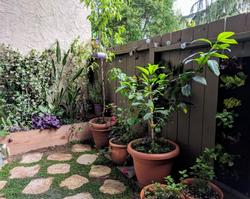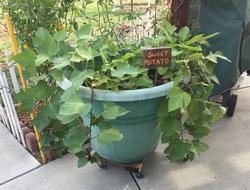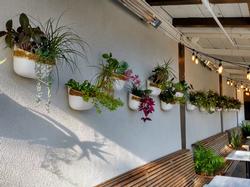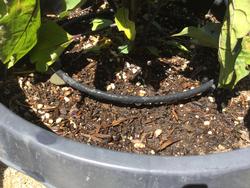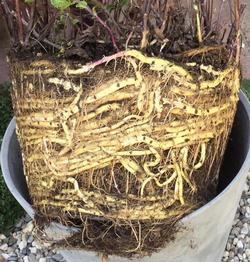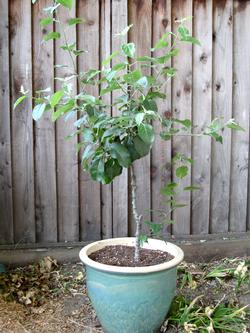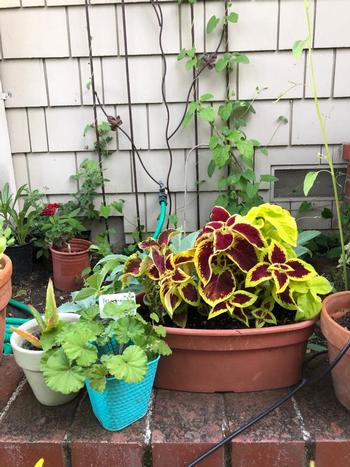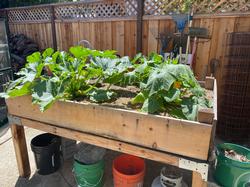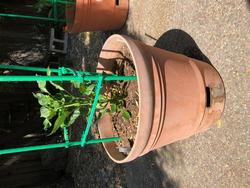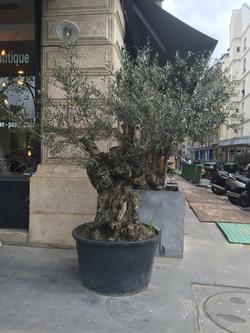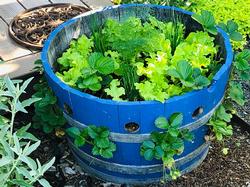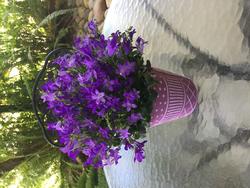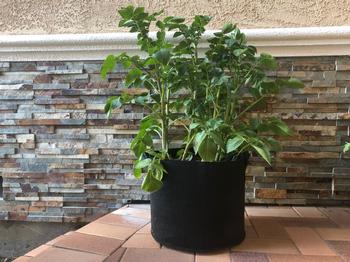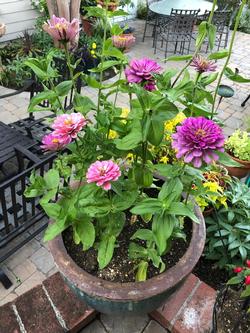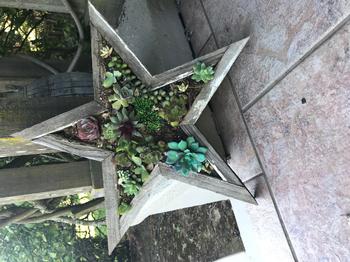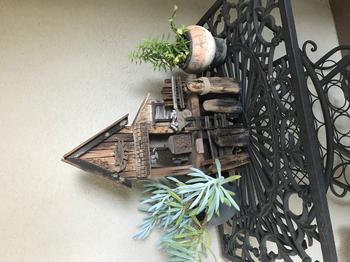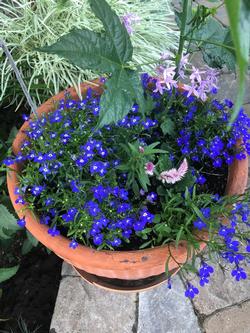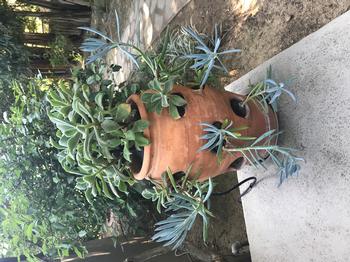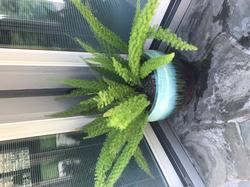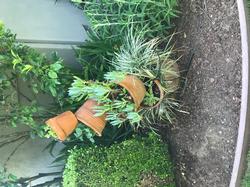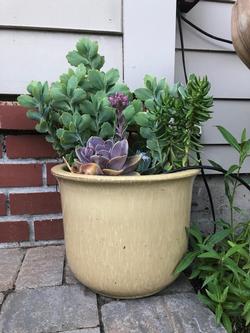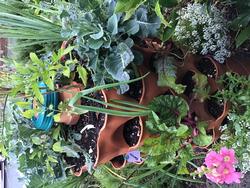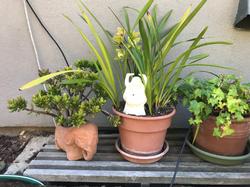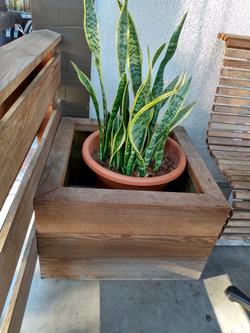Container Gardening Basics
Tips for a successful container garden
Container gardening can be a method of gardening for those who may not be able to have a traditional garden in the ground. It provides for a flexible planting site, freedom from poor soil, and the ability to move plants around with the seasons.
We'll discuss some requirements that are unique to container gardening. The intent is to highlight those that are most important so that you may be successful with your container garden.
Be sure to refer to our Garden Help links, for more general gardening tips for specific plants.
Sections:
- What to plant
- Container types
- Size of containers
- Location of containers
- Soil for containers
- Watering
- Fertilization
- Soil maintenance
- Pests and diseases
- References
- Ideas gallery
What to plant
- Almost any plant that can be grown in the ground can be grown in a container.
- Most vegetables are annuals (plants that live one season) and can be grown in containers.
- Most flowers can be successfully grown in containers, both annual and perennial (plants that live more than one season).
- Succulents grow particularly well in containers, and are frequently planted in colorful containers to make spectacular displays.
- Dwarf varieties of citrus and other fruit trees can even be grown in containers.
- Plants with similar light and temperature needs can be planted in the same container to add accent, color, and flair.
- Plants that spread aggressively from roots (mint, bamboo, berries, etc.) may be better planted in containers.
Container types
- Containers can be of many different materials and various sizes. Apart from aesthetics, the different materials have their own advantages and disadvantages.
- All containers should have drainage holes. If a drainage hole is not there it can usually be added using a household drill. Use a concrete or masonry bit for glazed or unglazed pots.
- Self-watering containers exist, but are more complicated than a plain pot. They need to be used with care, to avoid problems with either underwatering, overwatering, or inconsistent watering.
- Any recycled container should be disinfected with a bleach solution of 9 parts water to 1 part bleach.
Some of the different materials used for containers
- Clay or terra cotta pots are porous. They allow for aeration but also require more frequent watering.
- Plastic, glazed and cement pots are non-porous and maintain temperature and water at a more constant level.
- Wood planters made of cedar or redwood are naturally resistant to decay. Repurposed wood can be used for gardens, but it is advisable to avoid using wood previously treated with arsenic-based preservatives for vegetables and other edibles. See Selecting Lumber and Lumber Substitutes for Outdoor Exposures for more information.
- Metal planters can get hot and need more watering.
Size of containers
- Consider mature root depth (vertical) and spread (horizontal) when sizing a container for a particular plant.
- A deeper container is generally better than a wider container because it provides more space for roots to grow down, in search of water and cooler temperatures. This will benefit plants in hot weather.
- Shallow-rooted plants such as succulents and lettuce do well in lower-depth containers.
- In general, perennials develop a larger root system and require a larger/deeper container.
- Taller plants generally have larger root systems and therefore require larger containers.
- Most vegetables are annuals, which makes them ideally suited for containers. Vegetable root systems are varied, and matching container size to the root depth is important to maximize productivity. Following are container soil depth recommendations for popular vegetables:
- 6" to 9" for shallow rooted vegetables: chives, lettuces, green onions, radishes, spinach
- 12" to 18" for moderate depth vegetables: eggplant, peppers, beets, broccoli, carrots (short varieties), cauliflower, celery, chard, kale, peas
- 18" to 24" for deep rooted vegetables: tomatoes, potatoes, zucchini, winter squashes, beans, corn, cucumbers
Tips for vegetables: To get the most out of a limited space, plant high-yielding vegetables that your family likes to eat. High-yielding vegetables such as zucchini, tomatoes, eggplant, green beans, and cucumbers are good choices and are easy to grow. Use staking or trellising as required, in order to save space. Please visit our page on vegetable gardening in Santa Clara County, for more information.
Location of containers
- Place containers where they will receive the amount of sun or shade the plants need. Most vegetables need at least 6-8 hours of direct sun daily. Other plants may want full or partial shade.
- Heavy containers may be placed on a furniture or plant dolly if the plants need to move with the seasons.
- A south-facing wall may be too warm for some plants, particularly cool weather plants, but may be perfect for heat-loving plants.
- Raise containers off of hot cement with plant trivets, wood, or bricks.
Soil for containers
- Choose a good quality “potting mix” or “potting soil”. Potting soils are formulated specifically for containers. They hold moisture and provide good drainage which is necessary for healthy root growth. If purchasing potting soil in bags, be sure to keep the bags sealed to keep the unused soil from drying out and becoming hydrophobic.
- Some potting soils contain fertilizer pre-mixed into the soil. Be sure to read the label and follow directions.
- Do not use “planting mix”, “garden soil”, or “top soil” as your primary soil component. These are too heavy or otherwise unsuited as a container medium.
- Some plants require soil with a specific composition or drainage ability. It is best to cater to the plants' needs. Succulents are one example. A high quality potting soil mixed with expanded lava (pumice) is ideal for succulents and cacti.
- Do not put a layer of gravel or other material in the bottom of a pot 'to improve drainage'. It actually makes drainage worse.
Watering
- Consistent, sufficient watering is important for containers because they can dry out quickly. Drip irrigation on a timer can be a good solution for containers.
- Watering requirements will vary according to the season, type of container, and sun exposure.
- Check containers daily. Stick your finger into the top inch of soil. If it feels damp there is no immediate need for water. If it feels dry, water until some runs out the bottom of the container.
- Note: If a container dries out completely and the soil becomes hydrophobic, water may run through the container without actually moistening the soil. You may need to soak the entire pot or leave a slow drip on it to rewet the soil.
- In mid-summer and on windy days watering may be needed daily. In the heat of summer, it may be helpful to place a saucer under the pot that can fill with excess water and then be reabsorbed as needed. In winter, remove the saucer so the plants don’t sit in waterlogged soil.
Fertilization
- Many plants in containers need frequent, light fertilizing to grow well. Nutrients are leached out of the soil with every watering, so need to be replaced.
- Two ways to keep container plants well-fertilized are
- applying a light dose of a water soluble fertilizer with every watering, or
- including a slow release dry fertilizer in the soil.
- Many potting mixes contain fertilizers already, so be careful not to over-fertilize your plants.
Soil maintenance
- When growing annuals such as vegetables, container soil can be re-used as long as the plants were healthy during the growing season with no major disease issues. However, it is always good practice to refresh the containers for the new growing season with additional new potting soil and fertilizer.
- For perennials - with a properly-sized container, right planting mix, and right conditions, many plants will grow happily for years.
- If you begin to notice that the container is drying out too quickly, or it takes too long for the water to percolate through the soil, or you see that roots are protruding through the holes - it is likely time to repot the plant. Here is a video demonstrating how to repot a plant.
Pests & diseases
- Plants in containers can be subject to the same pests as in-ground plants. See our page on Pests & Diseases for more information or consult the listings for specific plants in our Garden Help section.
- You may need to cover or cage your container garden to guard against birds, squirrels, and other critters.
References
- California Master Gardener Handbook, Dennis R. Pittenger
- Vegetable Gardening Basics, UCCE Master Gardeners of Santa Clara County
- Container Gardening 101, UCCE Master Gardeners of Santa Clara County
- Growing Succulents, UCCE Master Gardeners of Santa Clara County
- Growing Fruit Crops in Containers, California Rare Fruit Growers Association
Fun ideas photo gallery
Below are some container gardening examples by members of the UCCE Master Gardeners of Santa Clara County. Please take a look - we hope these provide you with some ideas and inspiration for your own gardens!
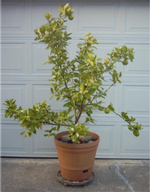
Citrus in a castered container
|
Use your imagination and be on the lookout for a creative use of containers!


